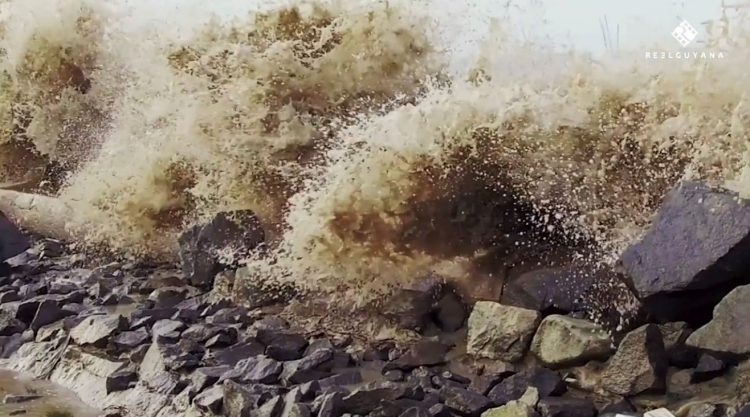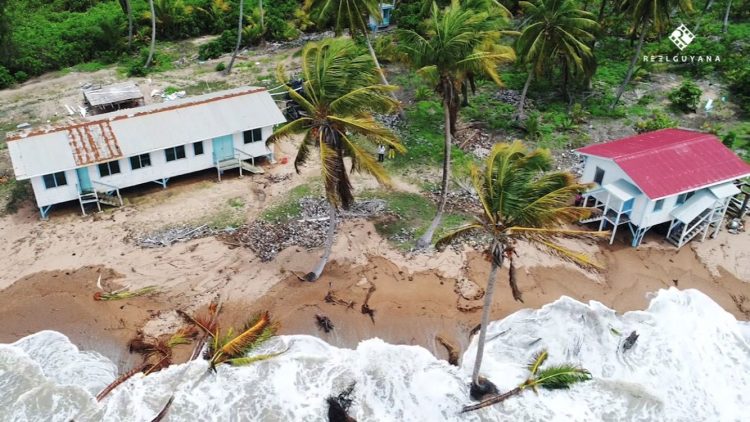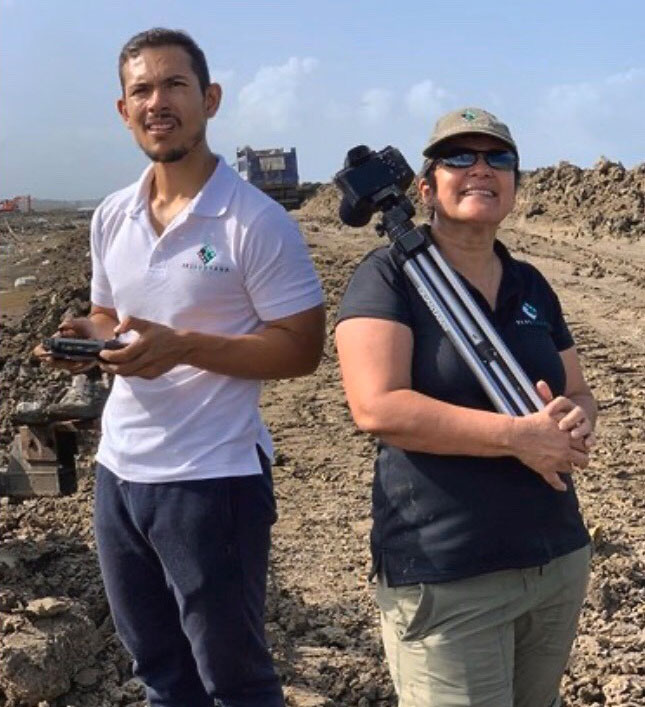With many Guyanese not being aware of the serious impact of climate change on our coastlines, environmental filmmaker, Alex Arjoon is bringing it to life with his latest documentary, Coast Land, that premieres today via Facebook.
Arjoon narrates the documentary that was filmed and produced by his production company, REEL Guyana. It shows footage, captured over a period of four years, of the physical changes to the coastline.
It also features Andrea Dutton, Geoscientist and Sea Level Rise expert, who notes the need for conversations and to “stay ahead of the rising sea and not go under.”

It shows massive overtopping and sea level rise with huge waves battering various parts of Guyana’s coast land. It also highlights the impact on Shell Beach and Almond Beach in the North West, near the Venezuelan border.
Arjoon told Stabroek News (SN) that filming, especially

with the raging waves was not without constraints and that he and his team found themselves in risky situations.
“I remember one of my first shoots the tide was so high and the waves were so intense that I damaged and lost all my equipment. That was a major setback for me but I managed to bounce back eventually,” he said.
The half-hour long documentary captures huge waves tumbling over sea walls in areas such as Mahaica and Buxton, East Coast Demerara and Den Amstel on the West Coast as well as in Kitty, near the Russian Embassy.
The floodwaters sweep into yards and farmlands in some areas, destroying rice, cash crops and livestock.
The flooding also poses a health hazard with overflowing latrines and sewage mixing with the floodwaters.
The documentary also featured the massive destruction in the Mahaicony area, caused by a breach in the sea defence in July 2019.
Residents, especially the farmers were hard hit by the devastation. Farmers said they had never seen flooding to that magnitude.
It had left them counting their losses, amounting to millions of dollars and millions more of taxpayers’ money in rectification.
The breach has still not been sealed and the foreshore continues to erode.
Public Infrastructure Minister, David Patterson has said that $14 billion is needed between 2020 and 2022 to effect “urgent” repairs on 32.9 kilometers of Guyana’s sea defence. If not, locations across the coast will suffer a fate similar as Mahaicony.
Guyana has 473.3 kilometers of sea coastline, which runs from Shell Beach to Corentyne.
Shell Beach
Arjoon narrated that the recurring erosions are displacing natural sea defences. Mangrove forests act as a buffer, shielding the coast from wave action.
Sadly, at Shell Beach there has been a significant decrease of the mangrove forest, which leaves the coast directly exposed to wave impact. This may be as a result of rising temperatures.
Arjoon’s mother, Annette Arjoon-Martins who was involved with the Protected Shell Beach area and a resident of Almond Beach for 30 years, shares her experience with coastal effects and tidal wave actions.
Arjoon-Martins, a Marine Conservationist and environmentalist, recalled that Almond Beach was a thriving community of 380 residents.
But “…In 2012 the waves and the wind were getting stronger and the waves going higher and higher.” The overtopping destroyed the infrastructure and three rows of coconut trees that were uprooted one after the other.
Within three years most of the residents moved to Mabaruma, but they did not have the avenue to continue their traditional farming and fishing.
Currently there are only about three dozen residents in Almond Beach.
The documentary also shows Arjoon sharing his experiences along with snippets from the film during a panel discussion at Moray House titled: Climate Change in Guyana – Effects and Responses.
Accomplishment
A major accomplishment was being able “to do this project in collaboration with a dedicated team who gave their full effort and support throughout this whole process. There were definitely some difficult times but we persisted and made it through.”
He said too that while filming the project they “met Guyanese from different backgrounds living all along our coastal region who all had unique stories and it truly was a privilege to be able to just talk to them and get to hear many different perspectives that went well beyond what we covered in our film.”
He said his mother “definitely was a big help in guiding this project in its earliest stages. …She was the one pushing for us to monitor the coast and film the different scenarios of overtopping and affected communities. Essentially she planted the seed that has now evolved into our biggest project of the year.”
He told this newspaper that he felt grateful and privileged that Guyanese are giving REEL a chance to tell these stories. He knows that the industry is not the easiest in terms of opportunity but he thinks it is “important to tell stories that shape the narratives of the younger generation and shine light on issues we can collectively address.”
The young filmmaker recognizes the need for “more perspectives from the younger folks who aren’t afraid to work together despite their differences because these are the people who will take Guyana forward.”
Not shelving the idea of a follow up sequence, he noted that his “biggest challenges in Guyana within any creative field is the financial support that makes these pieces feasible. Obviously this one was done on huge personal and financial investment but it is a story we’ve been wanting to tell for a while and something Guyana needs to know about…”
In May 2019, Arjoon launched a mini documentary series on adventure tourism titled ‘Inside REEL.’
The documentaries consist of six episodes about eight to 10 minutes long.
They captured breathtaking footage of the nature and wildlife in Guyana’s hinterland locations, featuring the Rupununi including Apoteri, Rewa and Yupukari among other places.
Arjoon is excited about the film’s premiere and hopes that it would help citizens to have conversations to understand the serious impact of climate change and the steps that can be taken to prevent it.






